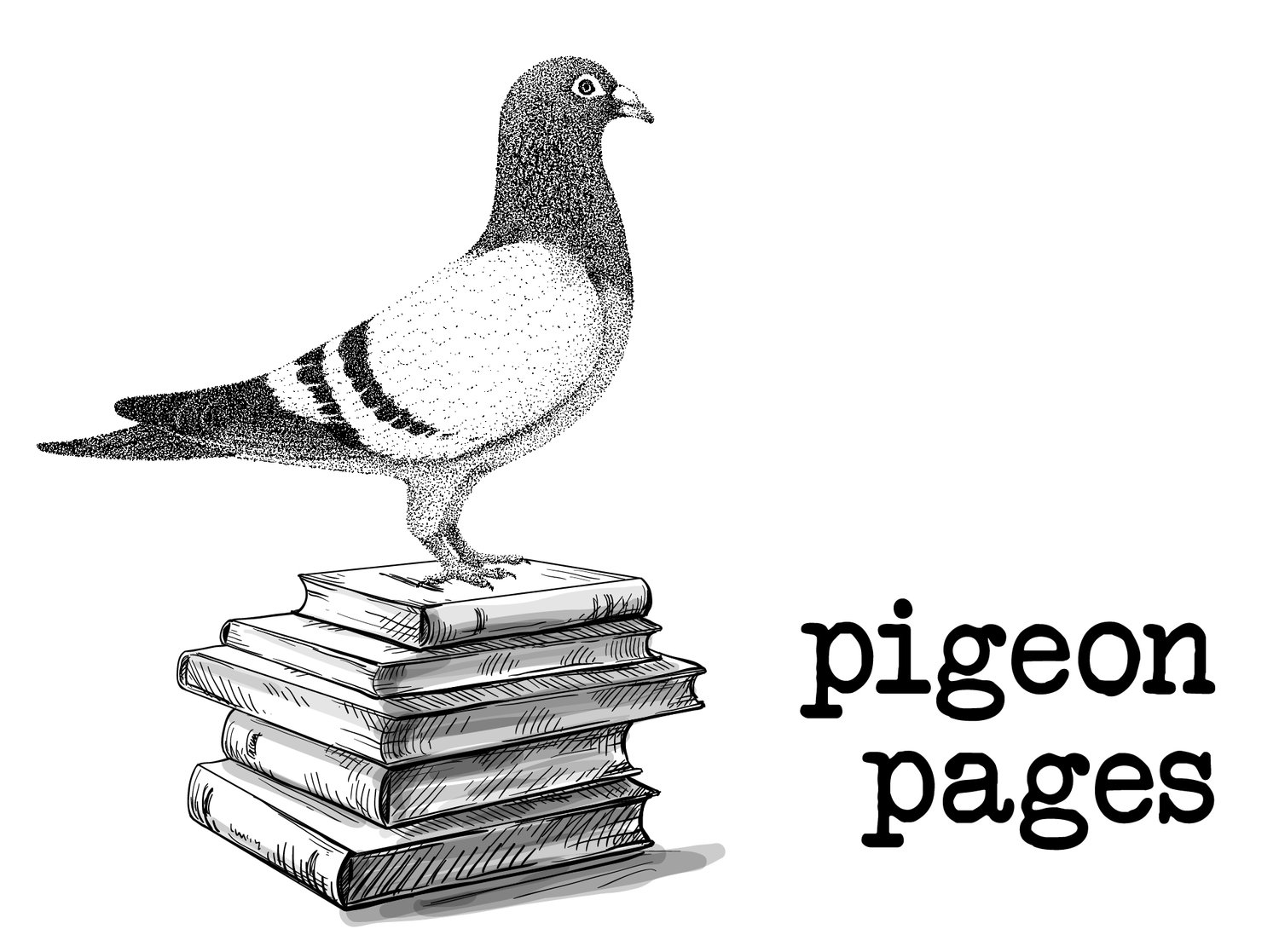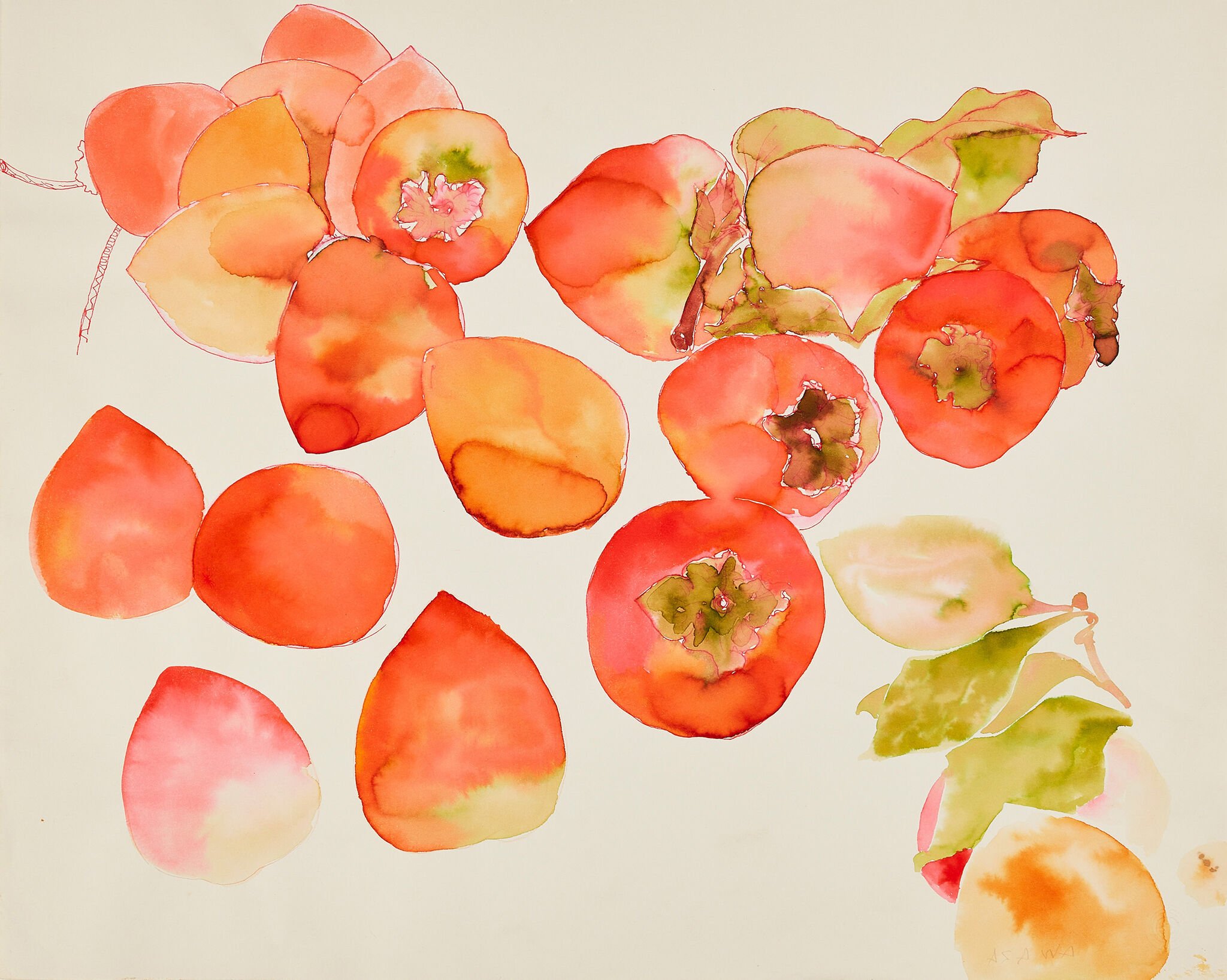Ruth Asawa, Untitled (WC.252, Persimmons), c. 1970s–80s. Watercolor on paper, 14 × 17in. Image courtesy of the Whitney Musuem of American Art.
How to Eat a Frozen Persimmon
(in Northern China, 1994)
by Yan Ruan
A 2023 Flash Contest Honorable Mention
Step 1: Get the ingredients. The best persimmons to use are round, ripe, with a tinge of red. You’ll go with Ba after the first frost. Hold on tight to his waist from the back seat, while his bike swerves into the sooty morning air. Keep your mouth closed, don’t let the sharp wind punch sour into your stomach like a fist. Wear a hat. When the bike’s clattering turns into a chirpy rattling, you’re on the dirt road to the morning market. Pick out a few dozen persimmons, medium-soft and unbruised. “The softest persimmons are pinched the hardest,” your Ba always says. “So are people.” You nod every time. You just turned ten a few weeks ago. The boxful of persimmons are tangerine lanterns on your lap, lighting up the sleepy, dust-luscious streets. I will be waiting at home with hot porridge. Careful with the squeaky door on the way in, your little brother is still asleep.
Step 2: Store the persimmons. Line them up tidy along the unheated hallway, right up to Four-eyes Chen’s rusty bike and waist-high coal pile. You might have to rearrange the bok choy and potatoes and other winter vegetables we’ve stocked up to make room. If the frostbite on your hands acts up, wear gloves; the brown ones have thicker finger pads. If the pain gets bad, try to remember how much you like working with Ba in silence like two comrades; or, better yet, how much you like seeing him sweating with a childish tangerine glee, boasting about how you are just as useful as a son to Four-eyes Chen’s woman. “Lucky you! My four boys won’t even curl a finger to pour their own urine pots!” Four-eyes Chen’s woman will exclaim while padding over to the communal bathroom. You’ll smile politely at her, like the proper eldest daughter I taught you to be.
Step 3: Freeze the persimmons. Don’t fuss with them. Leave them in the hallway and let the northern wind do its trick. Distract your brother with preserved plums or boiled peanuts when he gets a hankering for persimmons, until they turn into a frozen delicacy. Some old Northerners call them “drinks of honey” but I prefer the other name, the lesser known one, “poor man’s ice cream sundae.” Poor is what we are, and we make do with what we have. Wait for the persimmons to wilt, their tangerine glow to grey, and all the juice slowly solidifies into candied ice. You’ll know they are ready when a fine coat of white ice-dust covers them all the way like powdered sugar, which takes about a month.
Step 4: Serve the frozen persimmons. Offer them in December when your brother cries for an ice cream sundae, as he always does every time we walk past a McDonald’s. You know better than to ask why your brother gets ice cream every Tuesday afternoon, but you’re only treated to one when you get all 100s on final exams. You know to lie and say you’d rather have the frozen persimmons instead, just like how you’ve seen me doing the same, passing the plate of fatty pork belly directly to your uncle, claiming I don’t like the taste. Remember to say it not too quietly nor too loud. You have not yet mastered the art of lying convincingly, to me or to yourself, but you will learn soon enough, from me, from my mother, and from all the mothers that we’ve come from. Quiet your chopsticks. Keep the teapot full.
Step 5: Eat the frozen persimmons. Sit by the big radiator, the one we toast-dry our socks on, and enjoy. Use a knife or a sturdy spoon to get to the meat of the fruit. Do it gently. Take small bites. Let the thick honey brim and bubble and fill your whole mouth with creamy sweetness. Save the center, the chewy, syrupy tongue of the persimmon, the best part, for last. Be careful not to break the bitter skin. Even the sweetest persimmon has bitter, that’s just the way it is. The sooner you accept it, the better.
Published January 14th, 2024
Yan Ruan is a Brooklyn-based writer and artist. Born and raised in Beijing, Yan writes fiction and poetry in English as her second language. She holds a Ph.D. in Social Psychology at University of Rochester, and is currently pursing a MFA in Fiction at Brooklyn College. Yan’s work appears on Volume Poetry, The Rumpus, and elsewhere.
Ruth Asawa (b.1926-d.2013) was a Japanese American artist known for her wired sculptures. Asawa was one of seven children to Haru and Umakichi Asawa, seasonal farmers from Southern California. As a child, Ruth helped out on the farm where she sometimes made patterns in the sand of which she later contributes as a major influence on her art. In 1942, as a result of the United States’ racist immigration policies against Japanese Americans, Ruth's father was arrested by the FBI and sent to an internment camp in New Mexico. Ruth, her mother, and five of her siblings spent the next four years incarcerated at multiple internment camps in the American Southwest. Here, Ruth found communities among other artists. In 1946, Ruth studied at Black Mountain College, where she honed her craft under the guidance of many renowned artists of different mediums, such as painters, dancers, architects, and mathematicians. Although primarily known for sculptures, Ruth reportedly drew every day as part of process of refining perception. Her drawings, paintings, and prints are known for their line work and inspiration drawn from the natural world. (https://ruthasawa.com/)

